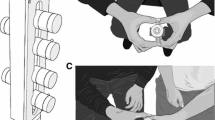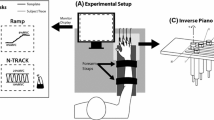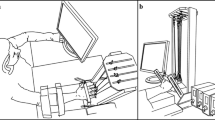Abstract
We used the framework of the equilibrium-point hypothesis (in its updated form based on the notion of referent configuration) to investigate the multi-digit synergies at two levels of a hypothetical hierarchy involved in prehensile actions. Synergies were analyzed at the thumb–virtual finger (VF) level (VF is an imaginary digit with the mechanical action equivalent to that of the four actual fingers) and at the individual finger level. The subjects performed very quick vertical movements of a handle into a target. A load could be attached off-center to provide a pronation or supination torque. In a few trials, the handle was unexpectedly fixed to the table and the digits slipped off the sensors. In such trials, the hand stopped at a higher vertical position and rotated into pronation or supination depending on the expected torque. The aperture showed non-monotonic changes with a large, fast decrease and further increase, ending up with a smaller distance between the thumb and the fingers as compared to unperturbed trials. Multi-digit synergies were quantified using indices of co-variation between digit forces and moments of force across unperturbed trials. Prior to the lifting action, high synergy indices were observed at the individual finger level while modest indices were observed at the thumb–VF level. During the lifting action, the synergies at the individual finger level disappeared while the synergy indices became higher at the thumb–VF level. The results support the basic premise that, within a given task, setting a referent configuration may be described with a few referent values of variables that influence the equilibrium state, to which the system is attracted. Moreover, the referent configuration hypothesis can help interpret the data related to the trade-off between synergies at different hierarchical levels.







Similar content being viewed by others
References
Adamovich S, Archambault PS, Ghafouri M, Levin MF, Poizner H, Feldman AG (2001) Hand trajectory invariance in reaching movements involving the trunk. Exp Brain Res 138:288–303
Aoki T, Niu X, Latash ML, Zatsiorsky VM (2006) Effects of friction at the digit-object interface on the digit forces in multi-finger prehension. Exp Brain Res 172:425–438
Arbib MA, Iberall T, Lyons D (1985) Coordinated control programs for movements of the hand. In: Goodwin AW, Darian-Smith I (eds) Hand function and the neocortex. Springer, Berlin, pp 111–129
Asatryan DG, Feldman AG (1965) Functional tuning of the nervous system with control of movements or maintenance of a steady posture. I. Mechanographic analysis of the work of the limb on execution of a postural task. Biophysics 10:925–935
Feldman AG (1966) Functional tuning of the nervous system with control of movement or maintenance of a steady posture. II. Controllable parameters of the muscle. Biophysics 11:565–578
Feldman AG, Latash ML (2005) Testing hypotheses and the advancement of science: Recent attempts to falsify the equilibrium-point hypothesis. Exp Brain Res 161:91–103
Feldman AG, Levin MF (1995) Positional frames of reference in motor control: their origin and use. Behav Brain Sci 18:723–806
Feldman AG, Levin MF (2009) The equilibrium-point hypothesis—past, present and future. Adv Exp Med Biol 629:699–726
Flanagan JR, Burstedt MK, Johansson RS (1999) Control of fingertip forces in multidigit manipulation. J Neurophysiol 81:1706–1717
Flanagan JR, Bowman MC, Johansson RS (2006) Control strategies in object manipulation tasks. Curr Opin Neurobiol 16:650–659
Friedman J, Flash T (2007) Task-dependent selection of grasp kinematics and stiffness in human object manipulation. Cortex 43:444–460
Gorniak SL, Zatsiorsky VM, Latash ML (2007a) Hierarchies of synergies: an example of the two-hand, multi-finger tasks. Exp Brain Res 179:167–180
Gorniak SL, Zatsiorsky VM, Latash ML (2007b) Emerging and disappearing synergies in a hierarchically controlled system. Exp Brain Res 183:259–270
Gorniak SL, Zatsiorsky VM, Latash ML (2009) Hierarchical control of static prehension: II. Multi-digit synergies. Exp Brain Res 194:1–15
Gysin P, Kaminski TR, Gordon AM (2003) Coordination of fingertip forces in object transport during locomotion. Exp Brain Res 149:371–379
Hajian AZ, Howe RD (1997) Identification of the mechanical impedance at the human finger tip. J Biomech Eng T ASME 119:109–114
Hinder MR, Milner TE (2003) The case for an internal dynamics model versus equilibrium point control in human movement. J Physiol 549:953–963
Hogan N (1985) The mechanics of multi-joint posture and movement control. Biol Cybern 52:315–331
Iberall T (1987) The nature of human prehension: three dexterous hands in one. In: Proceedings of 1987 IEEE international conference robotics automation, Raleigh, NC, pp 396–401
Johansson RS (1996) Sensory control of dexterous manipulation in humans. In: Wing A, Haggard P, Flanagan R (eds) Hand and brain, Academic Press, San Diego, pp 381–414
Johansson RS, Westling G (1984) Roles of glabrous skin receptors and sensorimotor memory in automatic control of precision grip when lifting rougher or more slippery objects. Exp Brain Res 56:550–564
Kang N, Shinohara M, Zatsiorsky VM, Latash ML (2004) Learning multi-finger synergies: an uncontrolled manifold analysis. Exp Brain Res 157:336–350
Kao I, Cutkosky MR, Johansson RS (1997) Robotic stiffness control and calibration as applied to human grasping tasks. IEEE Trans Rob Autom 13:557–566
Kluzik J, Diedrichsen J, Shadmehr R, Bastian AJ (2008) Reach adaptation: what determines whether we learn an internal model of the tool or adapt the model of our arm? J Neurophysiol 100:1455–1464
Kugler PN, Turvey MT (1987) Information, natural law, and the self-assembly of rhythmic movement. Erlbaum, Hillsdale, NJ
Latash ML (1994) Reconstruction of equilibrium trajectories and joint stiffness patterns during single-joint voluntary movements under different instructions. Biol Cybern 71:441–450
Latash ML (2008) Synergy. Oxford University Press, New York
Latash ML, Gottlieb GL (1990) Compliant characteristics of single joints: preservation of equifinality with phasic reactions. Biol Cybern 62:331–336
Latash ML, Gottlieb GL (1991) Reconstruction of elbow joint compliant characteristics during fast and slow voluntary movements. Neuroscience 43:697–712
Latash ML, Gottlieb GL (1992) Virtual trajectories of single-joint movements performed under two basic strategies. Neuroscience 47:357–365
Latash ML, Zatsiorsky VM (1993) Joint stiffness: myth or reality? Hum Move Sci 12:653–692
Latash ML, Zatsiorsky VM (2009) Multi-finger prehension: control of a redundant motor system. Adv Exp Med Biol 629:597–618
Latash ML, Scholz JF, Danion F, Schöner G (2001) Structure of motor variability in marginally redundant multi-finger force production tasks. Exp Brain Res 141:153–165
Latash ML, Kang N, Patterson D (2002a) Finger coordination in persons with Down syndrome: atypical patterns of coordination and the effects of practice. Exp Brain Res 146:345–355
Latash ML, Scholz JP, Schöner G (2002b) Motor control strategies revealed in the structure of motor variability. Exer Sport Sci Rev 30:26–31
Latash ML, Scholz JF, Danion F, Schöner G (2002c) Finger coordination during discrete and oscillatory force production tasks. Exp Brain Res 146:412–432
Latash ML, Scholz JP, Schöner G (2007) Toward a new theory of motor synergies. Mot Control 11:275–307
Li S, Danion F, Latash ML, Li Z-M, Zatsiorsky VM (2001) Bilateral deficit and symmetry in finger force production during two-hand multi-finger tasks. Exp Brain Res 141:530–540
Loeve M (1955) Probability theory. Van Nostrand, New York
Marsden CD, Merton RA, Morton HB, Rothwell JC, Traub MM (1981) Reliability and efficacy of the long-latency stretch reflex in the human thumb. J Physiol 316:47–60
Mason MT, Salisbury JK (1985) Robot hands and the mechanics of manipulation. The MIT Press, Cambridge
Milner TE, Franklin DW (1998) Characterization of multijoint finger stiffness dependence on finger posture and force direction. IEEE T Bio-med Eng 45:1363–1375
Niu X, Latash ML, Zatsiorsky VM (2007) Prehension synergies in the grasps with complex friction patterns: local vs. synergic effects and the template control. J Neurophysiol 98:16–28
Ostry DJ, Feldman AG (2003) A critical evaluation of the force control hypothesis in motor control. Exp Brain Res 153:275–288
Pilon J-F, De Serres SJ, Feldman AG (2007) Threshold position control of arm movement with anticipatory increase in grip force. Exp Brain Res 181:49–67
Rossi E, Mitnitski A, Feldman AG (2002) Sequential control signals determine arm and trunk contributions to hand transport during reaching in humans. J Physiol 538:659–671
Santello M, Soechting JF (2000) Force synergies for multifingered grasping. Exp Brain Res 133:457–467
Schmidt RA, McGown C (1980) Terminal accuracy of unexpected loaded rapid movements: evidence for a mass-spring mechanism in programming. J Mot Behav 12:149–161
Scholz JP, Schöner G (1999) The uncontrolled manifold concept: identifying control variables for a functional task. Exp Brain Res 126:289–306
Scholz JP, Kang N, Patterson D, Latash ML (2003) Uncontrolled manifold analysis of single trials during multi-finger force production by persons with and without Down syndrome. Exp Brain Res 153:45–58
Shadmehr R, Mussa-Ivaldi FA (1994) Adaptive representation of dynamics during learning of a motor task. J Neurosci 5:3208–3224
Shadmehr R, Wise SP (2005) The computational neurobiology of reaching and pointing. MIT Press, Cambridge
Shim JK, Latash ML, Zatsiorsky VM (2005) Prehension synergies in three dimensions. J Neurophysiol 93:766–776
Traub MM, Rothwell JC, Marsden CD (1980) A grab reflex in the human hand. Brain 103:869–884
Van Doren CL (1998) Grasp stiffness as a function of grasp force and finger span. Mot Control 2:352–378
Wolpert DM, Miall RC, Kawato M (1998) Internal models in the cerebellum. Trends Cogn Sci 2:338–347
Yang J-F, Scholz JP, Latash ML (2007) The role of kinematic redundancy in adaptation of reaching. Exp Brain Res 176:54–69
Zatsiorsky VM (2002) Kinetics of human movement. Human Kinetics, Champaign
Zatsiorsky VM, Latash ML (2004) Prehension synergies. Exer Sport Sci Rev 32:75–80
Zatsiorsky VM, Latash ML (2008) Multi-finger prehension: an overview. J Motor Behav 40:446–476
Zatsiorsky VM, Li Z-M, Latash ML (2000) Enslaving effects in multi-finger force production. Exp Brain Res 131:187–195
Zhang W, Scholz JP, Zatsiorsky VM, Latash ML (2008) What do synergies do? Effects of secondary constraints on multi-digit synergies in accurate force-production tasks. J Neurophysiol 99:500–513
Zhang W, Olafsdottir HB, Zatsiorsky VM, Latash ML (2009) Mechanical analysis and hierarchies of multi-digit synergies during accurate object rotation. Mot Control 13:251–279
Acknowledgments
Supported in part by NIH Grants AG-018751, NS-035032, and AR-048563.
Author information
Authors and Affiliations
Corresponding author
Rights and permissions
About this article
Cite this article
Latash, M.L., Friedman, J., Kim, S.W. et al. Prehension synergies and control with referent hand configurations. Exp Brain Res 202, 213–229 (2010). https://doi.org/10.1007/s00221-009-2128-3
Received:
Accepted:
Published:
Issue Date:
DOI: https://doi.org/10.1007/s00221-009-2128-3




